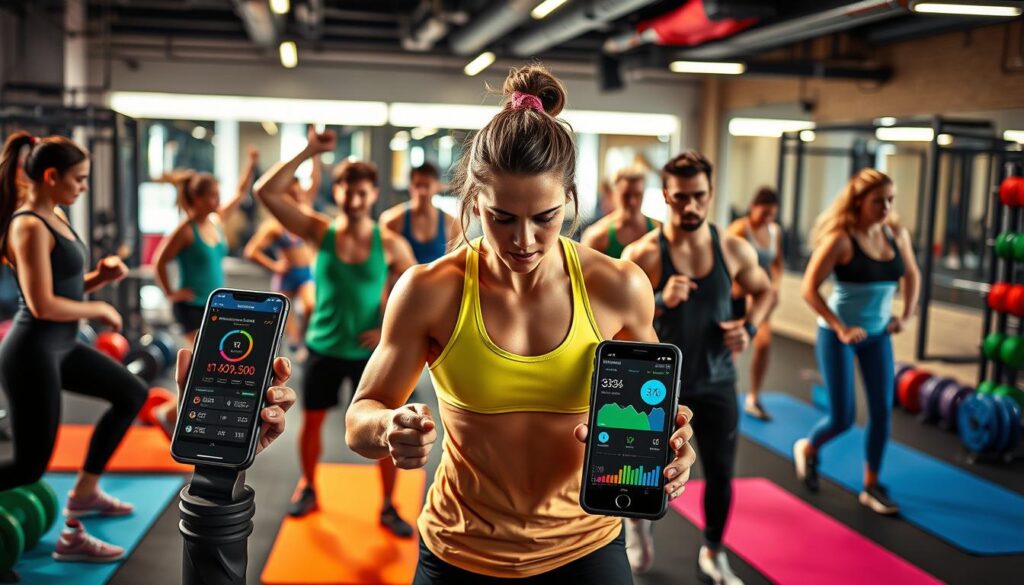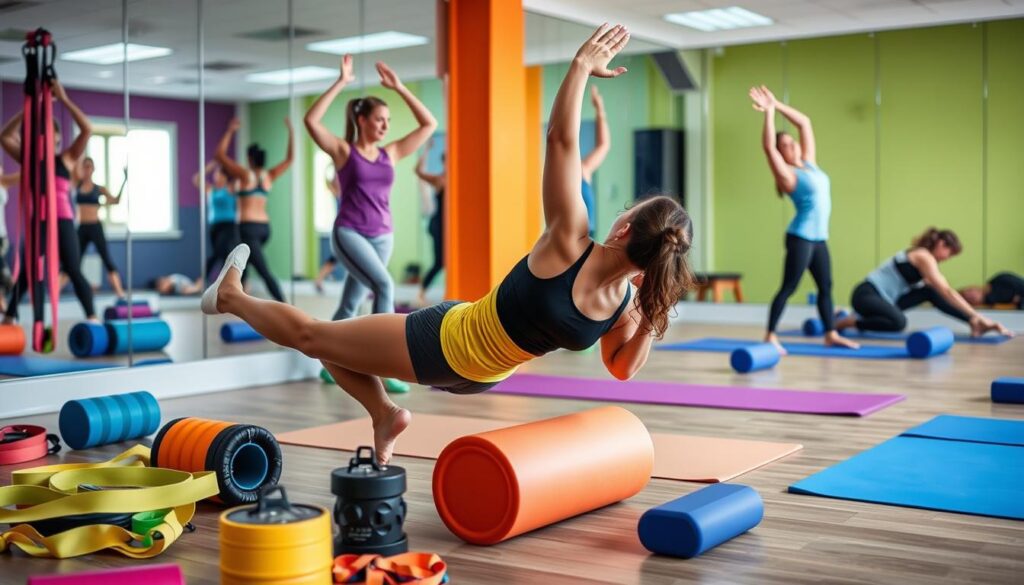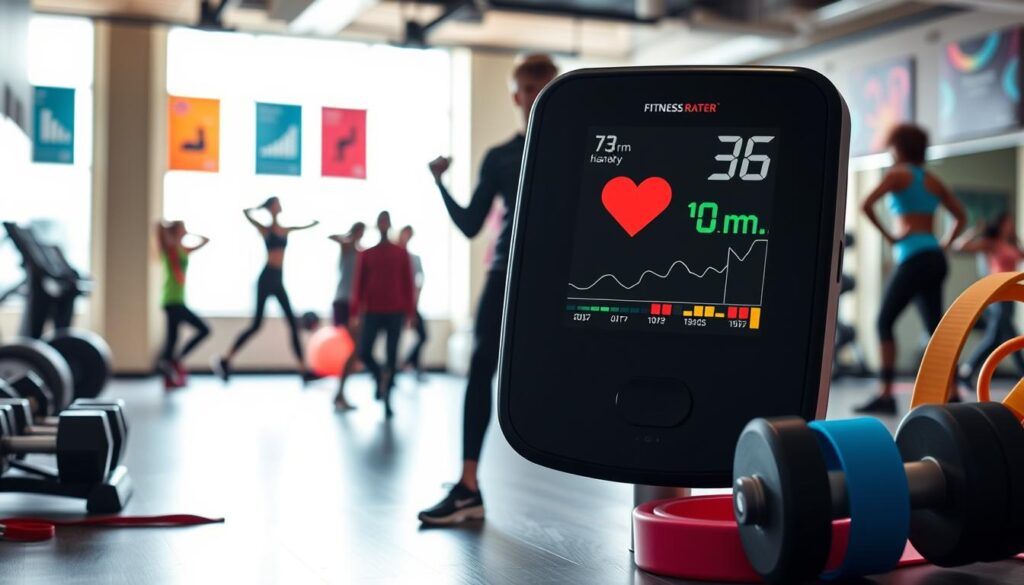
Calculate Your Fitness Level Like a Pro
To start calculating your fitness level like a pro, it’s key to know why a fitness assessment tool is important. It helps you see where you stand now and sets goals for getting better. With the right steps, you can figure out your fitness level like a pro and reach your fitness goals.

Using a fitness assessment tool is vital for calculating your fitness level like a pro. It gives you a full picture of your fitness, showing you what to work on. By figuring out your fitness level like a pro, you can make a fitness plan that fits you perfectly.
Key Takeaways
- Calculating your fitness level like a pro requires a fitness assessment tool
- A fitness assessment tool provides a comprehensive overview of your fitness level
- Calculating your fitness level like a pro helps you identify areas for improvement
- A personalized fitness plan can be created based on your fitness assessment results
- Using a fitness assessment tool is essential for achieving your fitness goals
- Calculating your fitness level like a pro helps you set realistic fitness goals
Understanding Fitness Level Assessment: The Professional Approach
To figure out your fitness level like a pro, you need to grasp the concept of fitness level analysis. This method checks your physical skills and health to find out your fitness level. Getting a professional fitness evaluation is key, as it gives a detailed look at your strengths and weaknesses.
A professional fitness evaluation looks at your fitness level through different tests. It checks your heart health, muscle strength, flexibility, and body shape. This helps spot areas to work on and helps make a fitness plan just for you.
Key Components of Fitness Assessment
The main parts of fitness assessment are:
- Cardiovascular endurance
- Muscular strength and endurance
- Flexibility
- Body composition
These parts are vital in figuring out your fitness level. They help in making a detailed fitness plan.
The Science Behind Fitness Evaluation
The science of fitness evaluation uses many methods and tools. It uses special equipment and software to track your progress. A professional evaluation looks at your fitness level to make a plan that fits your needs and goals.
Essential Equipment for Professional Fitness Testing
To find your optimal fitness level, you need the right tools. A fitness level calculator is key for professional fitness testing. It helps measure your fitness and sets a goal for betterment. When picking a fitness level calculator, think about what kind of test you want to do, like heart rate or strength.
Other must-have tools for professional fitness testing are:
- Heart rate monitors
- Blood pressure cuffs
- Body composition analyzers
- Flexibility and mobility assessment tools
These tools help experts figure out your optimal fitness level determination and make a fitness plan just for you. By mixing these tools with a fitness level calculator, you can accurately measure your fitness and work on getting better.
When picking out equipment for fitness testing, focus on accuracy and reliability. Choose tools backed by scientific research and proven to give accurate results. High-quality equipment ensures your fitness assessment is precise, helping you reach your fitness goals.
| Equipment | Description |
|---|---|
| Fitness Level Calculator | Assesses overall fitness and provides a baseline for improvement |
| Heart Rate Monitors | Measures heart rate during exercise and recovery |
| Body Composition Analyzers | Assesses body fat percentage and muscle mass |
Cardiovascular Fitness Measurement Techniques
Cardiovascular fitness is key to overall health. Measuring it well is vital to boost fitness. This can be done through fitness index calculation, which looks at heart rate, blood pressure, and oxygen use.
VO2 Max Testing Methods
VO2 max testing is a common way to check cardiovascular fitness. It measures oxygen use during hard exercise. You can do this on a treadmill or stationary bike. The results help figure out your fitness index.
Heart Rate Analysis Protocols
Heart rate analysis is another method to gauge fitness. It tracks heart rate during exercise. This helps see how fit you are. Using these protocols can help you get better and reach your fitness goals.
Endurance Assessment Tools
Tools like the Cooper test measure endurance and fitness. They help calculate your fitness index. This gives insights into your fitness level, helping you improve.
- VO2 max testing
- Heart rate analysis
- Endurance assessment tools
Using these methods and tools lets you accurately measure your fitness index. This helps you improve your fitness and reach your goals.
| Measurement Technique | Description |
|---|---|
| VO2 max testing | Measures oxygen consumption during intense exercise |
| Heart rate analysis | Monitors heart rate during exercise to determine fitness level |
| Endurance assessment tools | Measures endurance and cardiovascular fitness |
Strength and Power Evaluation Methods
Evaluating strength and power is key. An expert fitness level assessment is crucial. It shows where you stand and what you need to work on. Tests and measurements are used, like:
- One-rep max (1RM) testing to assess muscular strength
- Vertical jump testing to evaluate power
- Body composition analysis to determine lean body mass and body fat percentage
These tests help you understand your fitness level. They guide you in creating a training plan to boost strength and power.
It’s vital to have a professional, like a certified trainer, do the evaluation. They ensure the results are accurate. An expert fitness level assessment is the first step to reaching your fitness goals and enhancing your health.
| Test | Description |
|---|---|
| 1RM Testing | Assesses muscular strength by determining the maximum weight an individual can lift for one repetition |
| Vertical Jump Testing | Evaluates power by measuring the height an individual can jump |
| Body Composition Analysis | Determines lean body mass and body fat percentage to assess overall fitness level |
Calculate Your Fitness Level Like a Pro: Step-by-Step Guide
To figure out your fitness level like a pro, start with some basic steps. First, measure your current weight, body fat percentage, and overall health. A fitness tool can show where you are and help set goals for getting better.
With a fitness tool, you can watch your progress and tweak your workouts. This way, you can reach your fitness goals like a pro.
Baseline Measurements
Getting your baseline measurements is key to knowing your fitness level. This means:
- Body weight
- Body fat percentage
- Waist circumference
- Resting heart rate
Advanced Calculations
After getting your baseline, you can do more detailed calculations. This includes figuring out your:
- VO2 max
- Heart rate variability
- Body mass index (BMI)
Professional Scoring Systems
Professional scoring systems help you see where you stand and aim for better. Use a fitness tool to track your progress and adjust your workouts as needed.
Flexibility and Mobility Assessment Tools
When we talk about fitness, flexibility and mobility are key. A pro fitness check usually includes tests for these. These tests show where you might need to work on your fitness and track your progress.
Range of motion tests are a big part of checking flexibility and mobility. They see how far you can move your joints. This helps spot any movement limits, which can be fixed with special exercises and stretches. These tests give a full view of your fitness and how mobile you are.
Range of Motion Tests
- Shoulder flexion and extension
- Hip rotation and flexion
- Knee flexion and extension
- Ankle dorsiflexion and plantarflexion
Dynamic movement screening is also key in checking flexibility and mobility. It watches how you move during activities like squats and jumps. This helps find any movement issues, which can be fixed with the right exercises. It helps you understand your fitness level better and find areas to improve.

Dynamic Movement Screening
This method helps improve your flexibility and mobility. It leads to better fitness and less chance of getting hurt. Using these tools in a fitness check gives a full picture of your fitness. It helps you find ways to get better.
Body Composition Analysis Techniques
Knowing your body composition is key to improving fitness performance. It’s about figuring out the mix of body fat, muscle, and other parts that make up your weight. A way to do this is through fitness index calculation, which looks at height, weight, and body measurements.
To boost fitness, understanding body composition is vital. There are many ways to analyze it, like:
- Hydrostatic weighing
- Dual-energy X-ray absorptiometry (DXA)
- Skinfold measurements
These methods help people learn about their body composition. For example, if someone has too much body fat, they can use fitness index calculation to find out how to lose fat and get fitter.
In the end, knowing your body composition and using tools like fitness index calculation can help you improve fitness performance. It’s a step towards reaching your health and wellness goals.
Interpreting Your Fitness Assessment Results
Understanding your fitness assessment results is key to a successful fitness journey. An expert fitness level assessment gives you a detailed look at your current fitness. It helps you see where you can get better. A fitness level calculator also shows your progress over time.
When looking at your results, keep these points in mind:
- Score rankings: Compare your scores to industry standards to determine your fitness level.
- Age and gender considerations: Take into account how your age and gender affect your fitness level and set realistic goals.
- Progress tracking: Use your results to track your progress and adjust your workout routine as needed.
Knowing your fitness assessment results lets you make a plan to get better. Always talk to a fitness expert to get the most out of your assessment and calculator.

With this knowledge, you’re on the path to reaching your fitness goals and living a healthy life. Remember, a professional fitness assessment is essential for accurate results and a good workout plan.
Creating Your Personalized Fitness Improvement Plan
To improve fitness performance, you need a plan made just for you. This plan should match your current fitness level. You can find out your level with a fitness assessment tool.
With this tool, you can see where you need to get better. Then, you can set goals that are within reach.
A good plan should have a workout schedule, advice on what to eat, and a way to track your progress. Use a fitness assessment tool to keep an eye on how you’re doing. This will help you stay on track and keep your motivation up.
Here’s how to make your own plan:
- Set specific and achievable goals
- Create a workout routine that suits your fitness level
- Track your progress using a fitness assessment tool
- Make adjustments to your plan as needed
By following these steps and using a fitness assessment tool to track your progress, you can improve fitness performance and reach your goals. Remember, getting fit takes time and effort. Stay consistent and patient.
Professional Tips for Accurate Fitness Testing
To get accurate fitness testing results, it’s key to follow professional tips. A professional fitness evaluation is vital to understand an individual’s fitness level. Before any test, it’s important to prepare well to get accurate results.
Preparation includes getting enough rest, eating well, and avoiding hard activities before the test. This ensures the results show the person’s true fitness. It’s also important to note that a professional should conduct the test to avoid mistakes.
Pre-Assessment Preparations
- Get enough rest and sleep before the test
- Eat a balanced diet to ensure proper nutrition
- Avoid strenuous activities before the test
A fitness level analysis is more than just physical fitness. It’s about finding areas to improve. By following professional tips, individuals can get accurate results. This helps them create a fitness plan that’s just for them.

Common Assessment Mistakes to Avoid
Mistakes to avoid include not warming up, not following instructions, and not sharing medical history. These errors can lead to wrong results and harm the person.
Conclusion: Mastering Your Fitness Assessment Journey
As you finish your fitness level assessment, you’re starting a journey to better health and performance. The expert fitness level assessment methods you’ve learned will help you calculate your fitness level like a pro. This knowledge will guide you in setting and reaching your fitness goals.
By checking your physical abilities often, you can see how far you’ve come. You’ll know what to work on and create fitness plans that fit you. Use the insights from this detailed assessment to guide you towards your fitness dreams.
Remember, fitness is personal. Stay dedicated, be patient, and adjust your approach as you learn more. With hard work and the right strategies, you can reach your highest potential. This will greatly improve your health and well-being.
FAQ
What are the key components of fitness assessment?
Fitness assessment covers several areas. These include cardiovascular fitness, strength and power, flexibility, and body composition analysis.
Why does professional fitness evaluation matter?
Professional fitness evaluation gives you accurate results. It helps you know your fitness level and set goals. It also follows scientific standards.
What essential equipment is needed for professional fitness testing?
You’ll need fitness calculators, VO2 max devices, and heart rate monitors. Also, tools for measuring strength, power, and body composition are crucial.
How can I measure my cardiovascular fitness?
You can measure cardiovascular fitness with VO2 max tests and heart rate analysis. Endurance tools also help assess your aerobic capacity and health.
What methods are used to evaluate strength and power?
Strength and power are tested with weightlifting and muscle strength tests. Power output measurements are also used.
How do I calculate my fitness level like a pro?
To calculate your fitness level, follow a step-by-step guide. It includes baseline measurements and advanced calculations. Use professional scoring systems to set goals.
What tools are available for assessing flexibility and mobility?
Range of motion tests and dynamic movement screening assess flexibility and mobility. They check joint flexibility and muscle tightness.
How can I analyze my body composition?
Body composition is analyzed with body fat percentage and fitness index calculations. Advanced tools provide a detailed look at lean and fat mass.
How do I interpret my fitness assessment results?
To understand your results, look at score rankings and compare to standards. Consider age and gender factors. This helps identify strengths and weaknesses.
What are some professional tips for accurate fitness testing?
For accurate testing, prepare well before the assessment. Avoid common mistakes and follow testing frequencies. These tips ensure reliable results.
You may also like
You may be interested
The Only Fitness Calculator You’ll Ever Need!
Welcome to the ultimate guide to finding the best fitness...
“Unlock Your Fitness Potential in Seconds!”
Getting in shape can seem hard, but what if you...
Track Your Calories, BMI, and Goals Hassle-Free
Welcome to our guide on tracking your calories, bmi, and...
Leave a Reply